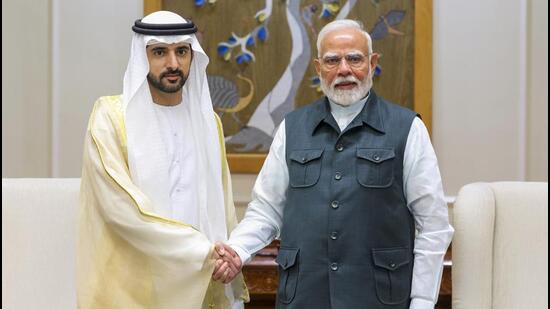
- At the core of the visit is a strong slate of initiatives aimed at deepening and diversifying economic relations.
- The ship-repair clusters and establishment of overseas campuses of top Indian schools mark a new direction, with Dubai hoping to be a center of high-quality educational achievement and cross-border business partnership.
- India’s shift towards the Gulf, and more specifically, Dubai, has been motivated by realistic interests: diversified energy supply, growing network of trade ties, and strategic need to offset regional instability.
UAE Crown Prince Sheikh Hamdan al Maktoum’s first official visit to India is being welcomed as a turning point in the Indo-UAE relationship. Beyond the working lunches and symbolic gift exchanges are profound issues concerning the nature of this shifting partnership and the general strategic calculus governing these encounters.
Upon his arrival in New Delhi, the Crown Prince was greeted with a ceremonial guard of honor, an invitation that was as much a political overture as it was a personal welcome. The move was followed by the prince presenting a replica of Sheikh Rashid’s ‘bisht’, an embroidered traditional cloak, to PM Modi. This present is not just a nod to the two countries’ shared cultural past; it is a gesture of symbolism, bringing decades of generational heritage together with modern-day political ambition.
Ambitious Economic and Educational Initiatives
At the core of the visit is a strong slate of initiatives aimed at deepening and diversifying economic relations. Announcements of setting up ship-repair clusters in Kochi and Vadinar, and the starting of pioneering projects like a Virtual Trade Corridor (VTC) and the establishment of overseas campuses of top Indian schools such as the Indian Institute of Management Ahmedabad and the Indian Institute of Foreign Trade (IIFT) in Dubai are seen as game changers. These projects mark a bold new direction toward a knowledge-based economy, with Dubai hoping to be a center of high-quality educational achievement and cross-border business partnership.
As India-UAE trade has grown, trade volumes have come close to US$97 billion, with a target of non-oil trade at US$100 billion. India needs to balance its trade commitments with the UAE against domestic priorities with a focus on sustainable development.
Deepening Defense Ties: Opportunities and Cautions
Defense cooperation was another focus area during this visit. Talks between Crown Prince Hamdan, India’s Defence Minister Rajnath Singh, and other senior officials highlight a desire to increase cooperation in fields like co-production and co-development projects. This is part of a larger strategic intent: to build a strong defense partnership that extends beyond traditional arms sales. For India, while joining the UAE could counterbalance geopolitical uncertainties and increase strategic agility, it also has to navigate the risks of dealing with regimes that are often subject to international criticism for human rights and governance.
The Broader Geopolitical Context and Cultural Dimensions
An assessment of this visit also has to account for its location in the wider geopolitical arena. India’s shift towards the Gulf, and more specifically, Dubai, has been motivated by realistic interests: diversified energy supply, growing network of trade ties, and strategic need to offset regional instability. The UAE’s thriving trade, finance, and tourism industries and the large Indian diaspora providing a strong socio-economic bridge offer the country the role of a valuable partner reinforced by the fact that it presents an opportunity worth investing in by itself.
However, this dynamic also compels India to deal with the intricacies of dealing with allies whose models of governance are very different from liberal democratic standards. As much as economic necessity and cultural sympathies offer rich soil for development, there is also an ongoing controversy over whether such alliances can potentially undermine India’s dedication to human rights, civil freedoms, and institutional accountability.
A Call for Nuanced Debate
Sheikh Hamdan al Maktoum’s visit is a milestone as it represents a vision of enhanced bilateral cooperation in areas of education, trade, defense, and cultural exchange. Yet, as is the case with many such lofty gestures of statecraft, success will ultimately be measured not merely by the resounding declarations but by the sustained effect on the democratic and economic fabric of both nations.
For Indian policymakers, this visit must be an inspiration not just to pursue closer relations with rich and strategically located partners like the UAE but also to conduct a vigorous public debate regarding the values that govern these relationships. It is crucial to counterbalance the appeal of high economic growth and greater security with the requirement for transparent government and upholding human rights at home as well as in the wider context of international relations.
References:
- Ministry of External Affairs, Government of India. (2025, April 07). Official visit of His Highness Sheikh Hamdan Bin Mohammed Al Maktoum, Crown Prince of Dubai, Deputy Prime Minister and Minister of Defence of UAE (April 08–09, 2025). https://www.mea.gov.in/press-releases.htm?dtl/39391/Visit+of+Crown+Prince+of+Dubai…
- The Indian Express. (2025, April 08). Dubai Crown Prince begins his two-day landmark visit in India, meets EAM Jaishankar. https://indianexpress.com/article/india/dubai-crown-prince-india-visit-pm-modi-9931712/
- Arab News. (2025, April 08). Dubai crown prince arrives in India on official visit. https://www.arabnews.com/node/2596288/world
- Mint. (2025, April 09). Crown Prince Al Maktoum’s India visit: IIM-Ahmedabad, IIFT to set up campuses in Dubai | https://www.livemint.com/news/world/dubai-crown-prince-sheikh-hamdan-bin-mohammed-india-visit-iim-ahmedabad-iift-to-set-up-campuses-in-dubai-key-updates-11744161463247.html
Shashank is a Master’s student in Diplomacy, Law, and Business at O.P. Jindal Global University. He is also a researcher and coordinator at the Center for Global South and the Center for Southeast Asian Studies. His research interests include Southeast Asia, Chinese foreign policy, India’s Act East Policy, and global security dynamics. Views expressed are the author’s own.
